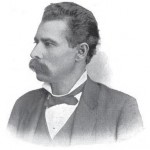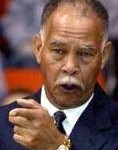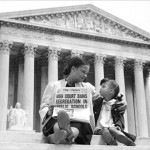Exhibition to examine Balthazar, a Black African king in Medieval and Renaissance European art
Curators seek your feedback on an exhibition-in-progress on one of the most prominent African figures in old master European painting
Image: Detail of “The Adoration of the Magi” from a Book of Hours showing the magus Balthazar (right), about 1480–90, Georges Trubert. Tempera colors, gold leaf, gold and silver paint, and ink on parchment, 4 1/2 × 3 3/8 in. The J. Paul Getty Museum, Ms. 48 (93.ML.6), fol. 59. Digital image courtesy of the Getty’s Open Content Program
(The Getty Museum) Early medieval written legends report that one of the three kings who paid homage to the Christ Child in Bethlehem was from Africa. But it would take nearly 1,000 years for European artists to begin representing Balthazar, the youngest of the three kings, as a black man. Why? The explanation can be found through a closer look at the history of this period—specifically, in the rise of the African slave trade in mid-1400s.
Delving into the Getty’s collections, we are at work on the exhibition Balthazar: A Black African King in Medieval and Renaissance Art (November 19, 2019–February 17, 2020). We are examining how Balthazar’s depiction coincided with and was furthered by the rise of the slave trade—and we invite your input to inform the exhibition. What questions or ideas do you have about this topic? What stories or themes would you like to see explored? We are eager to incorporate your views into our process. To comment publicly, leave a comment below or get in touch with us on social media @gettymuseum; to reach us individually, email us at manuscripts@getty.edu and we will reply directly.
To give context for the exhibition, in this post we’ll introduce the story of the Magi, and give an example of how Balthazar’s depiction intersects with the history of Western colonialism. (more)
2019 Aya Symposium at PVAMU
“Education: THE Foundation for Civil Rights in Texas Freedom Colonies”
 The Aya Symposium, in association with the Texas Purple Hull Pea Festival, will be held on Wednesday, June 19 (“Juneteenth”), 2019 at Prairie View A&M University in the School of Architecture. Texas educators, historians, and history enthusiasts are encouraged to attend. K-12 Texas educators will receive 7 CPE credits.
The Aya Symposium, in association with the Texas Purple Hull Pea Festival, will be held on Wednesday, June 19 (“Juneteenth”), 2019 at Prairie View A&M University in the School of Architecture. Texas educators, historians, and history enthusiasts are encouraged to attend. K-12 Texas educators will receive 7 CPE credits.
On June 19, 1865, more than two years after the Emancipation Proclamation, Texas’ enslaved residents were informed of their freedom. Almost immediately, these newly emancipated Texans began to assert themselves as resourceful, innovative citizens, forming more than 540 “Freedom Colonies” throughout the state during the mid-19th through the early 20th centuries as foundations in the fight for Civil Rights for Texans of African descent.
The goal of this symposium, entitled “Education – THE Foundation for Civil Rights in Texas Freedom Colonies” will be to explore the history of the educational systems and structures in Freedom Colonies, their influence on fostering and sustaining Black civil rights in the late 19th and early 20th centuries, and their impact on African-American Texans today.
For registration and more information, visit the Aya web site, www.ayasymposium.org/.
Twenty-Three Years of “In Black America” to be Restored, Digitized and Archived

John L. Hanson Jr., In Black America producer/host, in a control room in the new KUT studios in the Belo Building (Photo by Marsha Miller)
(KUT) Hundreds of “In Black America” interviews with newsmakers including, Stokely Carmichael, Yolanda King, Wilhelmina Delco, Maya Angelou, Dick Gregory and Barbara Jordan, will be restored, digitized and made available to the public thanks to a grant from Recordings at Risk, a national re-granting program operated by the Council on Library and Information Resources.
The nationally syndicated show, produced by KUT’s John L. Hanson Jr. and broadcast on 20 stations around the country, has featured weekly interviews with prominent African Americans since the early 1970s. Before 2004, these interviews were recorded and stored on 710 quarter-inch audio reels, which are now deteriorating.
Thanks to the grant, KUT will digitize the collection and add it to its archive, as well as donate copies to the American Archive of Public Broadcasting, a collaboration between the Library of Congress and WGBH to preserve and make historic public media accessible. Additionally, the digitized collection will be available for research at the Briscoe Center for American History at the University of Texas at Austin. (more)
TIPHC Bookshelf
 Published scholarship on black history in Texas is growing and we’d like to share with you some suggested readings, both current and past, from some of the preeminent history scholars in Texas and beyond. We invite you to take a look at our bookshelf page – including a featured selection – and check back as the list grows. A different selection will be featured each week. We welcome suggestions and reviews. This week, we offer, “Victory Courts: The Story of Coach Robert Hughes and the PVIL I.M. Terrell Panthers, by Robin L. Hughes.
Published scholarship on black history in Texas is growing and we’d like to share with you some suggested readings, both current and past, from some of the preeminent history scholars in Texas and beyond. We invite you to take a look at our bookshelf page – including a featured selection – and check back as the list grows. A different selection will be featured each week. We welcome suggestions and reviews. This week, we offer, “Victory Courts: The Story of Coach Robert Hughes and the PVIL I.M. Terrell Panthers, by Robin L. Hughes.
Robin L. Hughes chronicles experiences from the segregated Texas Prairie View Interscholastic League. The book focuses on the life and career of legendary basketball coach, Robert L. Hughes, and the direct influence he had on generations of young athletes in the Dallas/Fort Worth area. Victory Courts explores historical and socially relevant issues such as the role of family, community, education, and ways that high school and collegiate sports brought dignity and cultural change across the racially segregated Southwest during the 1950s and 1960s.
Teachers in the Prairie View League schools had high expectations for their students and therefore expected nothing less that greatness. High expectations from teachers and coaches resulted in decades of outstanding academic and athletic performances from hundreds of young Black males growing up in Fort Worth during an era when racial segregation shaped their daily lives. This standard of excellence is reflected in the life experiences and high expectations of Coach Hughes who grew up on a farm in Sapulpa, Oklahoma with seven siblings. The book reveals the major influence from his mother, who during the 1930s and 1940s instilled in them a sense of social justice activism and self-pride. According to the author, it is critical to highlight more than a glimpse of the historical and family context, because, historical circumstances and one’s family tends to shape and play a significant role in determining who you are, how you see the world, and who you may become.
“Victory Courts” is more than a sports book, it is an accessible look back on racial change, academic and athletic excellence, and the enduring high expectations and success of an extraordinary man focused on balancing his roles as educator, basketball coach, community leader, and his commitment to shaping the lives of generations of young Black men seeking their highest potential. This book is an excellent resource for anyone interested in civil rights era Texas history and African American struggles for access, equity, and excellence in the classroom and on the basketball courts. An excellent book for general audiences seeking to understand the relationship between sports, race relations in Texas, and academic success, Victory Courts represents a wonderful addition to any library.
This Week in Texas Black History
May 12
On this day in 1846, Norris Wright Cuney was born on a plantation near Hempstead. Cuney was the child of a white planter, Philip Minor Cuney and his slave, Adeline Stuart. Norris was educated at the Wylie Street School for blacks in Pittsburgh, Pennsylvania. He returned to Texas following the Civil War and settled in Galveston, where he became active in the Union League, the political arm of Radical Republican Reconstruction in Texas. Cuney became a powerful figure in Texas’ Republican circles, especially in Galveston and was appointed secretary of the Republican State Executive Committee in 1873, the highest party rank achieved by a Southern African American in the remaining decades of the century. In 1886, he was named the Republican Party’s national committeeman from Texas.
May 15
Robert Hughes, the most successful high school basketball coach in Texas history, was born this day in 1928 in Bristow, Oklahoma. After a tour in the U.S. Army during the Korean Conflict, Hughes played college basketball at Texas Southern University, gaining acclaim as a prolific scorer. In 1958, he became head coach at Fort Worth’s segregated high school I.M. Terrell. During his 16 years there (1958-1973), Hughes’ teams compiled a 373-84 record and won three Prairie View Interscholastic League (PVIL) state championships (1963, 1965 & 1967). The PVIL was the governing body for academic and athletic competitions for Texas’ African American high schools. With integration of public schools during 1973, Hughes became coach at Fort Worth Dunbar High School, where he remained until he retired in 2005. During his tenure at Dunbar, the “Flying Wildcats” won two state championships (1993 & 2003), and on three occasions finished second in the state. His teams made thirty consecutive trips to the state championship, and only had one losing season.
May 15
On this day in 1969, Dallas Cowboys’ great Emmitt Smith was born in Pensacola, Fla. Smith played collegiately at Florida, where he set 58 school records, then was the Cowboys first round pick (number 17 overall) in the National Football League‘s 1990 draft. He was an eight-time Pro Bowler, a four-time first-team All-Pro and led the league in rushing four times (1991, 1992, 1993, 1995). In 2002, Smith passed Chicago Bears great Walter Payton and became the league’s all-time rushing leader on an 11-yard gain in the fourth quarter of the Cowboys’ 17-14 loss to the Seattle Seahawks. Smith retired two years later with 18,355 yards to Payton’s 16,726. He was inducted to the Cowboys’ Ring of Honor in 2005 and into the Pro Football Hall of Fame in 2010.
May 17
The U.S. Supreme Court, on this day in 1954, handed down its landmark decision in Brown v. Board of Education declaring segregation in public schools to be unconstitutional. The court had consolidated five cases dealing with racial segregation in public schools (in Kansas, Delaware, the District of Columbia, South Carolina, and Virginia) under one name, Oliver Brown et al. v. the Board of Education of Topeka. Oliver Brown brought the case against the Topeka, Kan. Board of Education because his daughter, Linda, in third grade, had to cross railroad tracks and ride a school bus 21 blocks to a black school, even though there was a white school only five blocks away from her home. The court ruled unanimously that “separate educational facilities are inherently unequal.” The 1946 Heman Sweatt case against the University of Texas School of Law was a precedent for the ruling.
Blog: Ron Goodwin, Ph.D., author, PVAMU history professor
Ron Goodwin is an assistant professor of history at Prairie View A&M University. Even though he was a military “brat,” he still considers San Antonio home. Like his father and brother, Ron joined the U.S. Air Force and while enlisted received his undergraduate degree from Texas Lutheran University in Seguin, Texas. After his honorable discharge, he completed graduate degrees from Texas Southern University. Goodwin’s book, Blacks in Houston, is a pictorial history of Houston’s black community. His most recent book, Remembering the Days of Sorrow, examines the institution of slavery in Texas from the perspective of the New Deal’s Slave Narratives.
Recent Posts
The Everlasting Light
Ye are the light of the world. A city that is set on an hill cannot be hid. Neither do men light a candle, and put it under a bushel, but on a candlestick; and it givith light unto all that are in the house. Let your light so shine before men, that they may see your good works, and glorify your Father which is in heaven. — Matthew 5: 14-16
This is the month set aside to honor…(more)
The Return of the Silent Majority
Fifty years ago, in January 1969, Richard Nixon was sworn in as the thirty-seventh president of the United States. His legacy as President was marred by the Watergate investigations and his eventual resignation from office which overshadowed the way in which he won the office. His central campaign rhetoric was designed to garner support from white Southerners (otherwise known in history as the “Silent Majority”) whose racial beliefs leaned heavily towards the support of white…(more)
Submissions wanted
Historians, scholars, students, lend us your…writings. Help us produce the most comprehensive documentation ever undertaken for the African American experience in Texas. We encourage you to contribute items about people, places, events, issues, politics/legislation, sports, entertainment, religion, etc., as general entries or essays. Our documentation is wide-ranging and diverse, and you may research and write about the subject of your interest or, to start, please consult our list of suggested biographical entries and see submission guidelines. However, all topics must be approved by TIPHC editors before beginning your research/writing.
We welcome your questions or comments. Please contact Michael Hurd, Director of TIPHC, at mdhurd@pvamu.edu.




